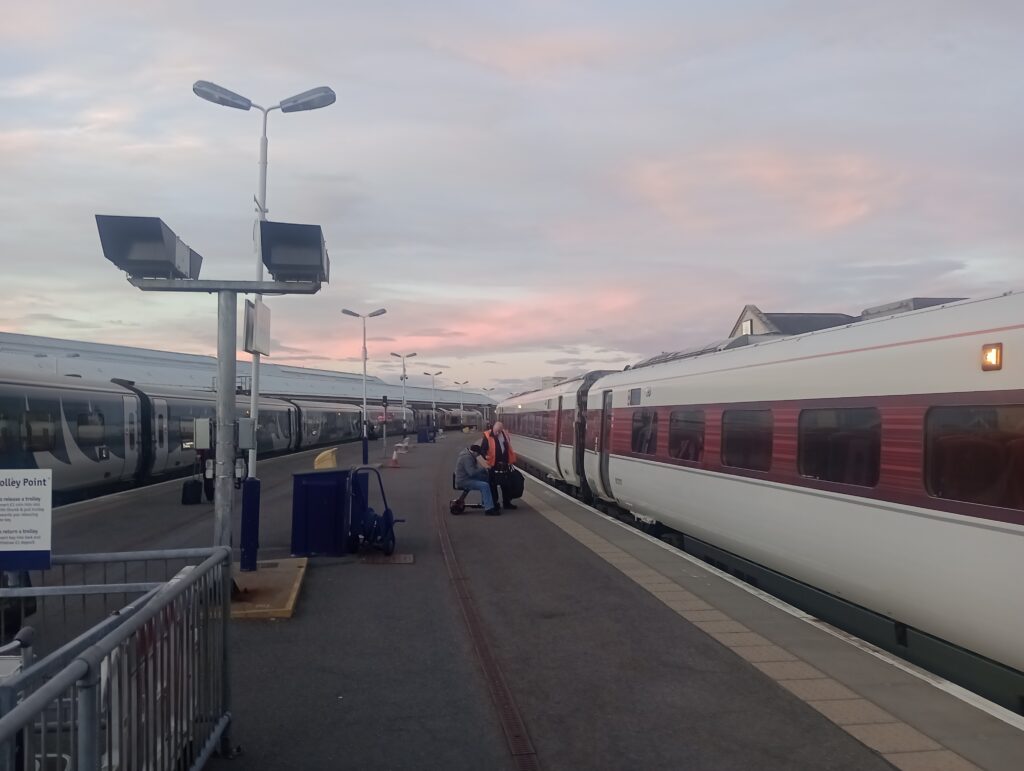Day 9 – a day to forget
The Premier Inn in Sunderland is like every other Premier Inn, comfortable and reliable. I’d only booked B&B because there were plenty of eating options around the hotel and PI Thyme restaurants are a bit basic and uninteresting. My room was on the first floor, but my window looked out onto the same level as a car park, the hotel being built into the side of a hill. No problems with noise and I slept well after a bottle of South African red from the Co-op. I went about 100 yards towards the city centre and next door to the Sunderland Empire found Aperitif, an Italian restaurant that was doing good business. I had a pint of Peroni with my mushroom bruschetta and then another with Pollo al Pepe, chicken with a pepper sauce and well cooked veg. Altogether a good meal before I retired to compose the blog with the aforementioned wine. The main dressing room of the Empire Theatre is said to be haunted by the ghost of Sid James who suffered a heart attack on stage and later died.
I had a good breakfast before leaving at about 0836, as I had arranged to meet an old college friend of mine for lunch just outside Middlesborough. Duncan lives close by and although we meet once a year it was a good opportunity to catch-up and have some lunch.
I made the inevitable wrong turns but found my way out of the city on some good bike tracks with variable surfaces but all hard and easy to cycle. I was still following NCR1 as it snaked its way south, annoyingly littered with pesky gates which seem to serve little purpose and, in some cases, are very difficult to get through with panniers.
I hadn’t reckoned on quite so much climbing but I was using the motor quite a lot on what were old railway lines so the train engines must have struggled similarly.I was down to sea level at Ryhope and Seaham but quickly climbing again and becoming concerned that I would miss my lunch date because of my slow progress, when at Hesleden I had the familiar sensation in my back wheel. I rang Duncan and said there was no way I would now make it in time, fixed the puncture and carried on to Hartlepool where, after a lot of wrong turns, I found Wet rock & ride, an atypically tidy bike shop where I bought a Schwalbe tyre with good puncture protection, which I immediately put on Lucy, and a couple of extra tubes. Hopeful that I was now past the puncture problems that have been plaguing me for the last couple of days I continued along the coast to Seaton Carew where I had a nice little spin along the prom
I was feeling a bit more chipper with my new tyre but schadenfreude struck as the heavens opened whilst I was on a particularly unpleasant bit of road, busy with a poor surface, that led into Middlesbrough. I was wearing a rain jacket but it’s not entirely waterproof but, more annoyingly my shoes were soaked with little chance that they would dry out. The rain stopped as I came to the Transporter bridge that has been closed since 2019. The only operational transporter bridge now left in the UK is the one at Newport, South Wales that I visited in 2020 when it, too, was closed, because of COVID. I was forced to make a 6 mile detour to cross the Tees
I had arranged to meet Duncan just south of Redcar at 1pm but, by the time I got to our meeting place it was 3.45. I cycled straight on knowing that I still had 30 miles to go to Whitby when 3 miles further on the front wheel punctured. Now I could understand the problem with the back tyre but the front tyre was brand new when I started. I checked inside it to see what had caused the problem but there was nothing obvious so I replaced the tube and hoped for the best: fortunately that was the end of punctures and tyre changing for the day. Fingers crossed that will be the end of them, full stop.
I dropped steeply down to Saltburn-by-the-Sea, an attractive little place and climbed out almost as steeply and followed the coast up and down, sometimes in sight of the sea, more often not.
These last 20 miles to Whitby were excruciating. Steep climbs and drops through the villages of Brotten, Carlin Howe, Boulby and Hinderwell had me aching to get off the bike but I gritted my teeth and finally made it to The White Horse and Griffin where I am staying the night. It’s not a day I want to remember and I only hope that my shoes dry out tonight.


